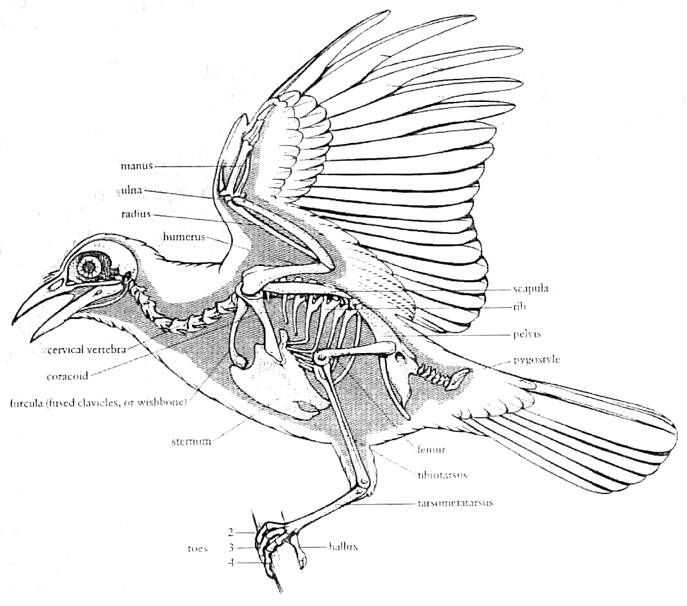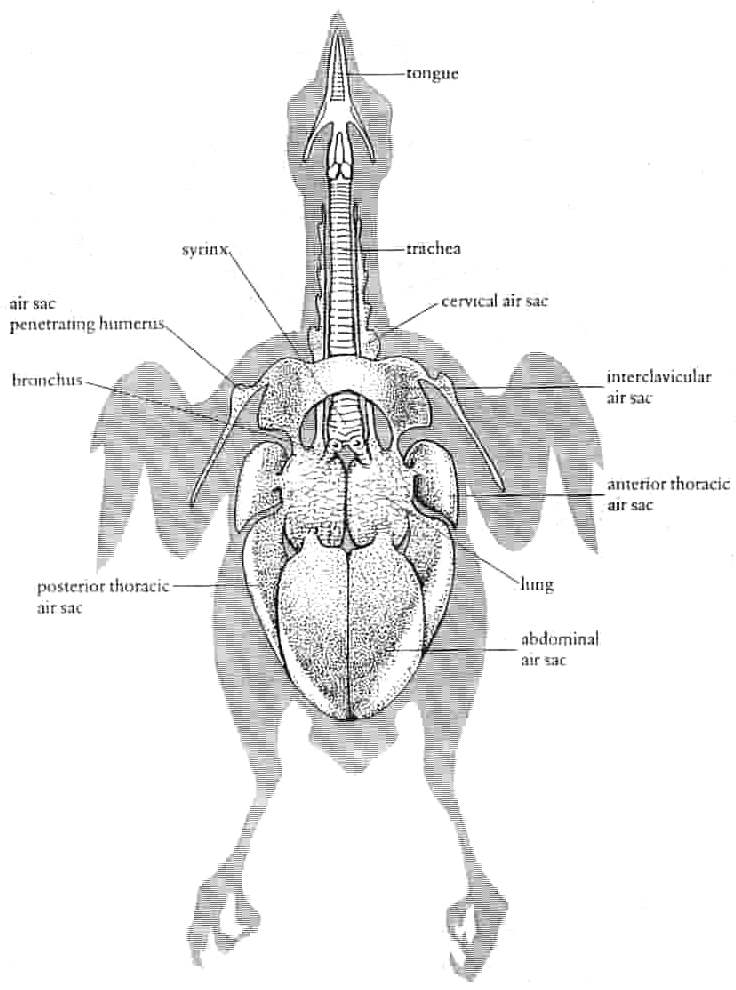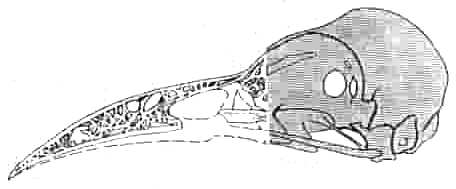|
I have in the past been impressed by the quality of Robert Hoey’s study of wing-tip feathers, as well as the studies of others, and what I present is of a much lesser quality. Also, I do not intend to remote control it, because too many things are going on, but rather I intend to fly it in person since it is too much for a radio control box. So the following is first in the nature of a caution to all of us who study and admire the better life form than ourselves, called collectively birds and, I offer a few observations taken directly from the Smithsonian’s great book Lords Of The Air, pages 117 to 139, because it behooves all to recognize the astonishing perfection of those we might hope to emulate. I feel strongly that before we launch ourselves into a new concept, we should consider our betters. (ed. – The Smithsonian material was too long for total reproduction on this site, but I have extracted the more pertinent pieces, as well as, include some of the drawings that illustrate the uniqueness of birds from Syd's perspective.) The following are excerpts from Lords Of The Air, by J. Page and E.S. Morton, published by The Smithsonian Book of Birds, Smithsonian Books, Washington, DC, 1989 (1995 reprint edition) (Topics include flight, food, migration, communication, societies, etc.) “. . .birds evolved a strong keeled breastbone to serve as an anchor for large flight muscles and thin, hollow bones that in many cases are fused together. They needed a large, efficient heart, a greatly refined respiratory system, and a high-energy diet.” (ed. – These are some of the attributes that Al Bowers mentioned last month that limited man from duplicating bird flight.) “Virtually everything about birds, in other words, is modified to meet the two basic requirements of all flying machines: low weight and high power. And, as in all engineering designs, most solutions are compromises. A hollow tube is far lighter but not as strong as a solid rod. Add a few well-designed internal struts to a hollow tube, and the result is a great gain in strength for a small addition in weight. Inside the wing bone of a vulture, one finds diagonal struts up and down the length like an endlessly repeated WW. In some airplane wings and steel structural members, engineers use a nearly identical configuration called the Warren truss, named for the engineer who invented it for the second time.” “Perhaps the most astonishing example of lightness is the frigate bird. While it has a wingspan of seven feet, its entire skeleton, including the skull, weighs a mere four ounces – less than its feathers and the same weight as two Grade A large chicken eggs.” “The fusion in birds of what we call collarbones (or clavicles) into the familiar wishbone (or furcula) used to be seen as part of the general strengthening of the chest area. But recently, using high-speed X-ray movies, scientists peered at the skeleton of a European starling thrashing away in a wind tunnel and noted what generations of children making wishes with the Thanksgiving turkey’s wishbone knew. It is highly flexible: you have to hang it up somewhere for several days before it is brittle enough to be used for wishing. Watching the starling’s wishbone in action, the scientists saw it open and close with each wing beat and realized that it serves as a spring. It stores energy on the downbeat and releases it to the wings on the upbeat. The wishbone may also assist the bird in breathing, pumping air throughout its respiratory system as it alternately bends and recoils. “How efficient is it to fly? According to Vance Tucker, also of Duke University, flying has it all over the locomotion of ground animals in terms of speed and endurance. Ducks cruise at speeds between 40 and 50 miles per hour. A cheetah, the fastest land animal, can achieve 70 miles per hour, but only for a short distance, after which it is so exhausted it needs a half-hour to recover. Neal Smith of the Smithsonian Tropical Research Institute in Panama has shown that broad-winged and Swainson’s hawks, by carefully using thermal updrafts and other air conditions, can soar from southern Texas and 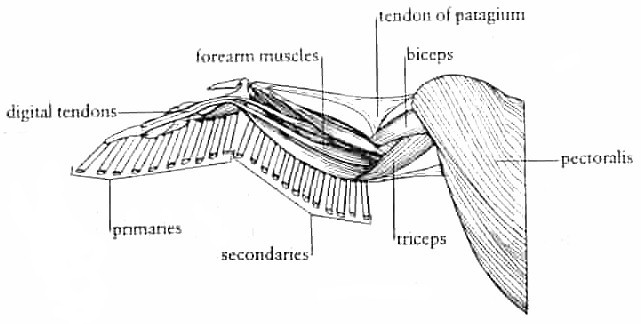 “The high metabolic rate of birds is costly. Thus it is to the bird’s advantage to conserve energy by flying as little as possible, and this is what they tend to do. Except in the rarest circumstance, birds never fly for what we might call the fun of it. As seen in many cases of flightlessness in birds, it is mainly predators that keep birds in the air. In their absence, birds tend to give up the entire expensive business of flight and act more like mammals.”
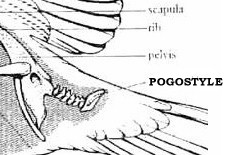 ABOVE
2 Diagrams: “Skeletal adaptations of birds include a flexible neck;
strong, light bones; nearly immobile or fused thoracic and abdominal vertebrae
and pelvic girdle providing a compact, rigid support structure for muscles;
and the keel-shaped sternum or breastbone and furcula or wishbone, to which
the massive primary flight musculature, above, is attached.” (RIGHT:
ed. - Syd wanted to make a point that the "pogostyle" was one of the most
important bones in the bird's structure.) ABOVE
2 Diagrams: “Skeletal adaptations of birds include a flexible neck;
strong, light bones; nearly immobile or fused thoracic and abdominal vertebrae
and pelvic girdle providing a compact, rigid support structure for muscles;
and the keel-shaped sternum or breastbone and furcula or wishbone, to which
the massive primary flight musculature, above, is attached.” (RIGHT:
ed. - Syd wanted to make a point that the "pogostyle" was one of the most
important bones in the bird's structure.)
-------------------------------------------------------------------------------------------------------------------- “Certain modes of flight
are more efficient than others. The amount of energy it takes to
soar in circles, making only fine adjustments to use thermal updrafts,
clearly is next to nothing compared with the blinding buzz of the hummingbird.”
“Birds with well developed tails tend to be good at landing, and for obvious reasons. A quick spreading and lowering of the tail at the appropriate moment, tied to a high angle of attack by the wings, causes an immediate and controllable stall. Some birds also use the tail as a kind of rudder, twisting it to one side or another to change direction, which can also be accomplished by changing the angle of attack – or the shape – of one wing compared with the other.” (ed. – This type of tail has been tried by Bob Hoey and his group and was also done on the Nighthawk by Jim Theis.) “. . . And, of course,
on this basic plan of airfoil and propeller, birds have developed as many
variations on a theme as Vivaldi, each suited to a particular need or set
of needs in the business of flying”
“The opposite is the high aspect ratio wing, in which the length is far greater than the width, like the wing of a glider plane, the analogue in aviation for the great gliders of the ocean – albatrosses, tropic birds, and the like. Slotting is rare among such glider’s (albatross) wings: the vortexes at the wing tips are too far apart to make much difference. Sailors in southern latitudes often will find themselves accompanied all day by an albatross making gentle S-curves behind, beside and ahead of their vessel, utter masters of the breeze.” “The third basic wing type is the high-speed wing, long and relatively slim, often with swept-back hands without slotting. More suited for fast, level flying than maneuverability and quick takeoffs, this is the wing of the falcon, of terns and sandpipers, swifts and swallows, and hummingbirds. It is among birds with such wings that many of the spectacular records in speed and aerial prowess are to be found. A peregrine falcon will fly normally between 40 and 60 miles per hour, but when it dives after prey, it may achieve speeds approaching 200. The fastest normal wing-flapping flight ever clocked was of the white-throated needle-tailed swift in India: a reported 219 miles per hour.” 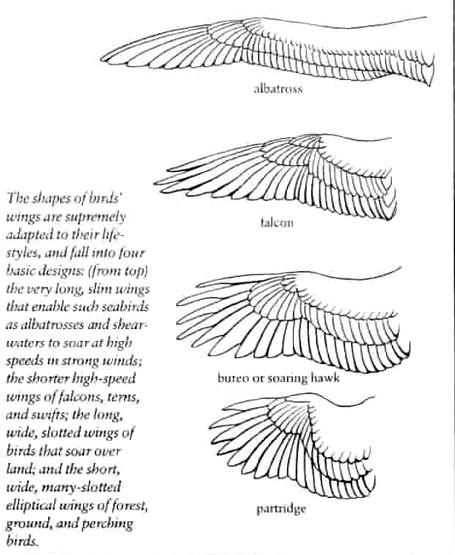 “The fourth basic wing
type is the slotted high-lift wing, which brings to mind eagles and most
birds of prey (but not falcons, which rely more on speed and thus are equipped
with high-speed, scimitar-shaped wings). This wing has a relatively
low aspect ratio with a strong camber and a typically high degree of slotting.
The result is a great deal of lift, needed not just to get the bird aloft
and keep it there – these birds are the great soarers – but also because
the bird will (if it is good at its job) find itself hauling fair-sized
prey in its talons.”
“All birds that fly are
especially sensitive to the air. Anything from a small gust to a
gale affects their progress through the sky, and they all make constant
adjustments. But soaring birds seem especially gifted in sensing
the invisible motions of the air. Wind blowing across an obstruction
– a wave, a sand dune, a shoreline, a hill – causes an updraft. An
albatross takes advantage of these evanescent updrafts in series, ascending
and descending, gliding for hours near the surface of the sea. (ed.
– Reminds me of the German video using an albatross to illustrate dynamic
soaring.) On land, an open area of field will warm up faster than
surrounding woodland, and the air over it rises in a great column.
Vultures will soar in circles on these thermals, defining their edges.
Meanwhile, over the sea, warming water sends air up in groups of thermal
columns, and gulls may be seen soaring in circles around them. If
there is a fresh wind – at least 24 miles per hour –
“It is the manipulation
of feathers – by the bird and the air – that allows for many of the subtle
maneuvers of birds in flight and on takeoff and landing. It is feathers
that permit birds to fly relatively soundlessly: imagine the human misery
if birds made proportionately as much noise in flight as airplanes.
It is feathers that turn what are chunky and awkwardly shaped bodies into
streamlined, aerodynamically sound fuselages. That birds spend a
good deal of time preening, dusting, oiling, and otherwise caring for their
feathers is no surprise: feathers are probably the most important pieces
of avian apparatus.”
“All told, the flight feathers and their associated coverts account for a small proportion of the feathers that cover a bird. Most of these are contour feathers, all of which typically grow from specific tracts on the skin, and down, which can grow almost anywhere and which provide insulation. Contour feathers usually have well-formed vanes that are downy at the base. They cover the body and give it its aerodynamic shape, though in many instances they have evolved into highly elaborate structures for display, as in such bizarre and beautiful creatures as the birds of paradise.” “In association with contour feathers are odd hairlike feathers called filoplumes with vestigial vanes at the ends. These feathers, which generally lie under the contour feathers, baffled ornithologists for some time. They were suspected of having some sensory role, and recently West German scientists studying pigeons found that the filoplumes are directly connected to sensory receptors in the skin that detect mechanical stimuli – this is, motion. If the filoplume, or the nearby contour feather, is wiggled, the signal is transmitted directly by the filoplume to the bird’s central nervous system. A contour feather that is out of place can cause a loss of heat. Perhaps more important, a contour feather this is ruffled cuts down on the streamlining of the bird’s body. And it may also be that a change in pressure on a contour feather during flight, once signaled via the filoplume to the central nervous system, plays a role in the constant fine tuning called for in the conduct of flight.” “There apparently is nothing – no feature – of these superb athletes that does not owe its original design and function to the overriding task of flight, the amazingly complex talent birds possess that is so unimaginably liberating and, at the same time, so elegant a straitjacket. (ed. – The second part (click here) is Syd’s design concept, since he asked that everyone absorb this piece before presenting the design. I will say it is an adaptation of an existing homebuilt ultralight sailplane and is, indeed, very interesting. I find it interesting how this all goes together with what Al Bowers covered in his March presentation. These excerpts show how much we have learned about the mechanics of flight from the experts, but also on how much we have yet to learn that will help with man’s quest for flight.) |
